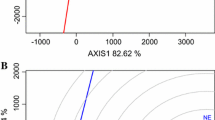Summary
Yield data obtained from a comparative small grain cereals trial, grown for five consecutive growing seasons at a total of 23 environments in Cyprus, were subjected to regression analysis. Within each environment, yield trials consisted of a standard set of three cultivars or elite lines of barley, triticale, durum and bread wheat. The regression coefficient (b) of crop mean on the environmental index (I) and the mean square deviation from regression (sd2) were calculated for each crop. Each crop tended to have its own characteristic value of sd2 and its magnitude was an excellent indicator of specific crop-environment interaction. The causes of large sd2, for two of the four crops, were the susceptibilith of barley to lodging, when favourable conditions were encountered at high yielding environments, and triticale dependence on late season precipitation. Durum wheat and triticale had an average response to different yielding environments (b>1.19) and both were significantly different from those of bread wheat (1.08) and barley (0.54). Hence, barley, bread and durum wheat are specifically adapted to low, average and high yielding Mediterranean environments, respectively. The cultivation of triticale at the expence of durum wheat is not feasible. Furthermore, interactions between crops and environments demonstrated by the regression parameters, should constitute the basis for decision making, regarding crop adaptation in a region. The average yield in all environments should not be considered as a proper criterion for adaptation. In this study, triticale had a similar mean grain yield (3,842 kg/ha) to that of bread wheat, but was significantly higher yielding than barley or durum wheat (5 and 7%, respectively).
Similar content being viewed by others
References
Allard, S.A. & A.D.Bradshaw, 1964. Implications of genotype-environment interactions in applied plant breeding. Crop Sci. 4: 503–507.
Eberhart, S.A. & W.A.Russell, 1966. Stability parameters for comparing varieties. Crop Sci. 6: 36–40.
Eberhart, S.A. & W.A.Russell, 1969. Yield and stability for a 10-line diallel of single-cross and double-cross maize hybrids. Crop Sci. 9: 357–361.
Finlay, K.W. & G.N.Wilkinson, 1963. The analysis of adaptation in a plant-breeding programme. Aust. J. Agr. Res. 14: 742–754.
Hadjichristodoulou, A., 1984. Performance of triticale in comparison with barley and wheat in a semi-arid mediterranean region. Exp. Agric. 20: 41–51.
Jensen, Neal F., 1952. Intra-varietal diversification in oat breeding. Agron. J. 44: 30–34.
Johnson, V.A., S.L.Shafer & J.W.Schmidt, 1968. Regression analysis of general adaptation in hard red winter wheat (Triticum aestivum L.). Crop Sci. 8: 187–191.
Joppa, L.R., K.L.Lebsock & R.H.Busch, 1971. Yield stability of selected spring wheat cultivars (Triticum aestivum L. em Thell.) in the Uniform Regional Nurseries 1959 to 1968. Crop Sci. 11: 238–241.
Lin, C.S., M.R.Binns & L.P.Lefkovitch, 1986. Stability analysis: where do we stand? Crop Sci. 26: 894–899.
Author information
Authors and Affiliations
Rights and permissions
About this article
Cite this article
Josephides, C.M. Analysis of adaptation of barley, triticale, durum and bread wheat under Mediterranean conditions. Euphytica 65, 1–8 (1992). https://doi.org/10.1007/BF00022193
Received:
Accepted:
Issue Date:
DOI: https://doi.org/10.1007/BF00022193




